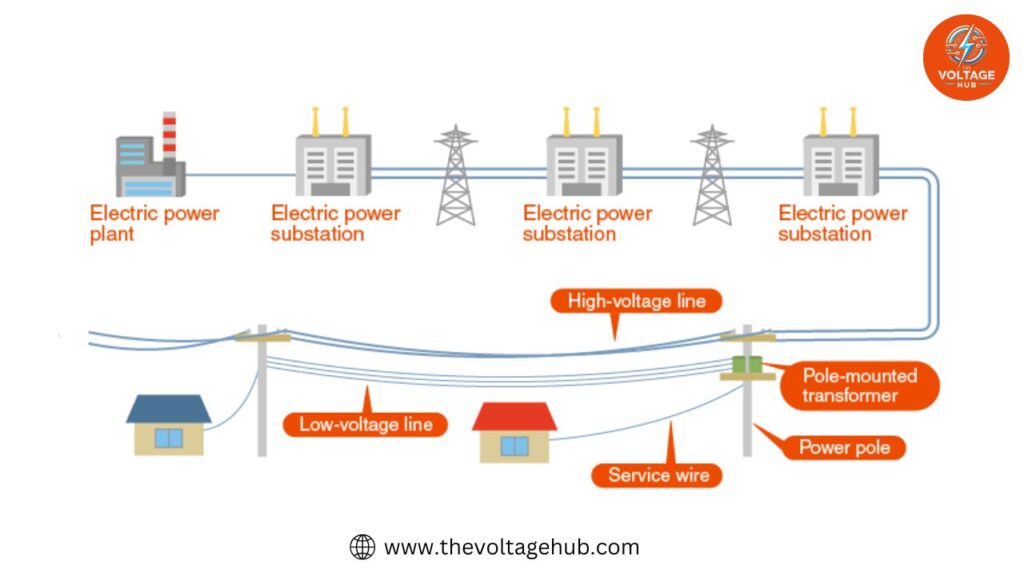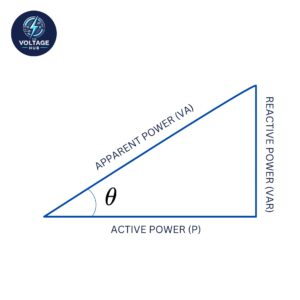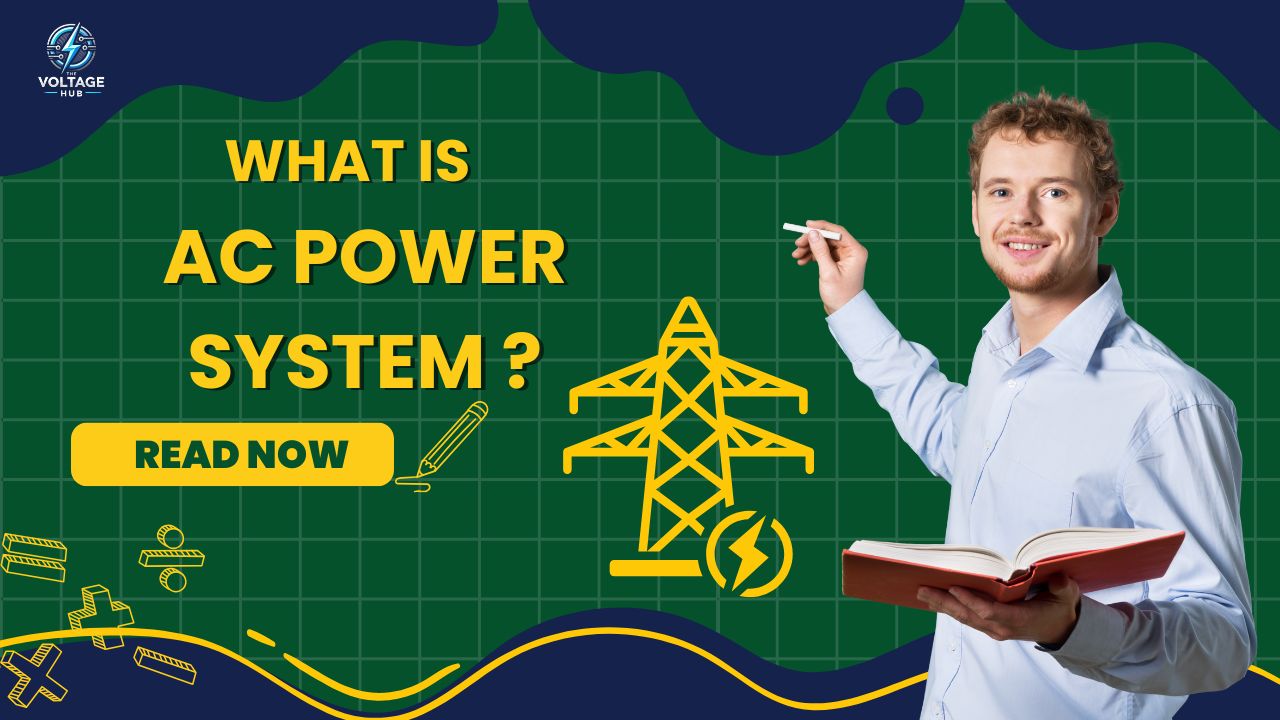Table Of Content
- 1 Introduction
- 2 Fundamentals of AC Power Systems
- 3 Principles of AC Power
- 4 Generation of AC Power
- 5 Types of AC Generators
- 6 Transmission and Distribution
- 7 Types of AC Power Systems
- 8 Power Factor and Efficiency
- 9 AC Power System Protection
- 10 Applications of AC Power Systems
- 11 Challenges and Future Trends
- 12 Conclusion
Introduction
The Alternating Current (AC) power system is the backbone of modern electrical infrastructure, providing efficient transmission and distribution of electricity over vast distances. Unlike Direct Current (DC) systems, where current flows in a single direction, AC systems alternate the direction of current flow, enabling numerous advantages in power generation and distribution.
AC power systems have revolutionized how we consume and distribute electricity, making it critical to understand their workings, challenges, and future potential. In this comprehensive guide, we delve into the intricacies of AC power systems, exploring their components, principles, types, advantages, and applications.
Fundamentals of AC Power Systems

AC power refers to the flow of electric charge that periodically reverses direction. Unlike DC power, which flows unidirectionally, AC power oscillates, making it more suitable for transmission over long distances due to lower energy losses. The sinusoidal nature of AC signals ensures smooth operation for most electrical equipment.
AC power is characterized by its sinusoidal waveform, representing how voltage and current vary over time. The standard frequency of AC power varies by region, typically 50 Hz in Europe and Asia, and 60 Hz in North America. This frequency difference has implications on equipment design and international power compatibility.
The evolution of AC power systems dates back to the late 19th century when pioneers like Nikola Tesla and George Westinghouse revolutionized electricity distribution. Tesla’s invention of the induction motor and his work on polyphase AC systems proved pivotal. The infamous “War of Currents” between Tesla’s AC system and Thomas Edison’s DC system ultimately led to the widespread adoption of AC due to its superior efficiency, scalability, and lower transmission costs.
AC power systems comprise several critical components that ensure the generation, transmission, and distribution of electricity:
-
Generators: Convert mechanical energy into electrical energy using electromagnetic induction.
-
Transformers: Adjust voltage levels to minimize losses during long-distance transmission.
- Transmission Lines: Carry high-voltage electricity over vast distances.
-
Distribution Systems: Step down voltage levels and distribute power to consumers.
-
Circuit Breakers and Fuses: Protect the system from overcurrent and short-circuit conditions.
Principles of AC Power
In AC systems, voltage and current alternate in direction and magnitude. This oscillation follows a sinusoidal pattern, described mathematically as: where represents frequency in Hertz (Hz), is time in seconds, and and are peak voltage and current.
The waveform of an AC signal ensures continuous energy supply without abrupt changes, unlike square or triangular waveforms.
RMS and Peak Values
Root Mean Square (RMS) values provide an effective measure of AC voltage or current. They are essential for calculating power: RMS values allow for direct comparison with equivalent DC values when determining power consumption.
AC power has additional components:

-
Active Power (P): The actual power consumed by resistive loads, measured in watts (W).
- Reactive Power (Q): Power associated with inductive and capacitive loads, measured in volt-amperes reactive (VAR).
- Apparent Power (S): The combination of active and reactive power, measured in volt-amperes (VA).
The relationship between these components is given by:
Generation of AC Power
The generation of AC power primarily occurs in large-scale power plants where mechanical energy is converted to electrical energy through the rotation of a generator’s rotor inside a stator.
Power plants harness various energy sources to drive turbines:
-
Hydropower: Utilizes water flow to turn turbines.
- Fossil Fuels: Burns coal, oil, or gas to produce steam.
- Nuclear Energy: Uses nuclear fission to heat water.
-
Renewable Sources: Employ wind and solar technologies.
To illustrate, consider a typical hydropower plant. The gravitational force of falling water drives a turbine connected to an AC generator. The rotational energy turns a magnetic rotor within a coil of wire, inducing alternating current through electromagnetic induction.
Types of AC Generators
-
Synchronous Generators: Maintain constant output frequency by synchronizing the rotor speed with the grid.
- Induction Generators: Commonly used in wind turbines for variable speed applications.
Thermal and hydroelectric power plants dominate global energy production, while wind and solar farms are increasingly significant contributors to sustainable energy.
The mechanical energy sources that drive AC generators differ across industries:
- Thermal Power Plants: Use steam turbines driven by heat from fossil fuel combustion.
- Hydroelectric Dams: Rely on water flow.
-
Nuclear Reactors: Generate heat through fission.
Transmission and Distribution
Transmission lines carry high-voltage power from generation stations to substations. Using higher voltages reduces energy loss due to resistance. Transmission voltages typically range between 110 kV and 765 kV.
Transformers are essential in AC systems, as they step up the voltage for transmission and step it down for distribution:
- Step-Up Transformers: Increase voltage for efficient long-distance transmission.
- Step-Down Transformers: Reduce voltage for consumer safety and appliance compatibility.
The importance of transformers is highlighted by their ability to minimize resistive losses. According to Joule’s law, power loss in a conductor is proportional to the square of the current (). By increasing voltage and reducing current, transformers ensure minimal energy dissipation.
Distribution networks involve primary and secondary systems to deliver electricity efficiently:
- Primary Distribution: Supplies power to large industrial consumers.
- Secondary Distribution: Delivers lower voltage power to residential areas.
Modern distribution systems include automated technologies to monitor and optimize power flow.
Types of AC Power Systems
Single-phase and three-phase power systems are the most common types:
- Single-Phase Systems: Use one alternating voltage source. Typically found in homes, it consists of two wires: phase and neutral.
- Three-Phase Systems: Use three alternating voltages, each 120 degrees out of phase. This system offers balanced power and is common in industrial and commercial settings.
Three-phase systems are preferred for their efficiency in transmitting large amounts of power over long distances. The total power output remains constant, reducing vibration and mechanical stress on machinery.
Power Factor and Efficiency
The power factor (PF) indicates how effectively electrical power is being used. Defined as:
A low power factor indicates inefficient power usage, often caused by inductive loads. Improving power factor reduces electricity costs and improves system efficiency.
Techniques for power factor correction include:
- Capacitors: Store energy and release it to counteract inductive loads.
- Synchronous Condensers: Adjust reactive power dynamically.
Power factor improvement is crucial in industrial plants where large motors and inductive loads dominate. Installing capacitors in parallel with these loads can lead to significant cost savings by reducing demand charges on utility bills.
AC Power System Protection
Electrical protection systems prevent damage due to faults. Common protective devices include:
- Circuit Breakers: Interrupt current flow during faults.
- Fuses: Melt when current exceeds safe levels.
Protective relays detect abnormal conditions and activate circuit breakers to isolate affected areas.
Grounding systems protect users and equipment by providing a safe path for fault currents. For example, grounding in household wiring prevents electric shock by directing stray currents into the earth.
Applications of AC Power Systems
AC power drives most aspects of modern life:
- Industrial Applications: Powering machinery, conveyor systems, and lighting.
- Commercial Buildings: Operating HVAC systems and elevators.
- Residential Use: Powering appliances, lighting, and entertainment systems.
Renewable energy systems, including solar and wind, integrate with AC grids using inverters to convert DC output to AC. In a solar power system, photovoltaic cells generate DC power, which an inverter then converts into AC suitable for home or grid use.
Challenges and Future Trends
AC systems face challenges such as reactive power losses and the complexity of voltage regulation. However, advancements in smart grid technologies and power electronics continue to enhance reliability and efficiency.
Emerging trends include:
- Microgrids: Localized grids that can operate independently.
- Energy Storage Systems: Balancing supply and demand.
Smart grids incorporate advanced metering infrastructure (AMI) and automated distribution systems to optimize power flow, reduce outages, and integrate renewable energy sources seamlessly.
Conclusion
The AC power system remains a cornerstone of electrical infrastructure, combining reliability, efficiency, and scalability. By addressing current challenges and leveraging new technologies, AC systems will continue to evolve, supporting the world’s growing energy needs.


